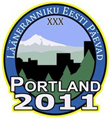Helmuth Kalmann
On the occasion of the 30th West Coast Estonian Days it seems fitting to provide an overview of the origins and development of the festival over the last 58 years in addition to providing data on the participation and leadership. In the second section we summarize the origins and activities of the West Coast Estonian League (WCEL/EOLL) itself, the broadest organization of Estonians on the coast.
The fact that the centers of Estonian life on the West Coast are separated by large distances was both a hindrance and a driving factor in the creation of the festival. The founding of local Estonian societies, congregations, veterans clubs, etc., had laid a basis for organized local social activity in communities along the coast, but not much was initially accomplished in a broader ethnic effort because of the small number of Estonians scattered in communities separated by hundreds of miles. Something more had to be done— and thus was born the idea of organizing an event to encompass the entire West Coast.
Preliminary steps were taken when theater and sports enthusiasts from Los Angeles made a second visit to San Francisco on 25 October, l952. The directors of the L.A. orchestra and theater, Eerik Laid and Eduard Kikas, proposed the organization of a “California Estonians’ Summer Days.” To follow-up, the Los Angeles Estonian Society made a former proposal to the Estonian Society of San Francisco to arrange such a festival. Under the leadership of their society chairman, John Ostrat, a five person delegation from San Francisco went to Los Angeles in early March, l953, for more detailed discussions.
In these discussions, it was decided to broaden the invitations to include the Estonians of Oregon and Washington, and instead of putting on a “California Estonians’ Summer Days”, it was decided to organize a “West Coast Estonian Days”. San Francisco was chosen to be the initial host, with the festival scheduled for the three-day Labor Day weekend of 1953. The festival was repeated in Los Angeles two years later, in l955, and by l957, in Portland, it was clear that the West Coast days had become a tradition. In the coming years, the Estonian communities of Vancouver, B.C, and Seattle joined in organizing the event.
The idea that Estonians on the American West Coast should work more closely together had arisen earlier. In l952, the Estonian societies of Los Angeles and San Francisco had already met. But a formal proposal was made by Arno Bender on 10 May, l954, when he was attending a board meeting of the San Francisco Estonian Society. A. Bender stressed the need to give West Coast Estonians a secure status in the broader American Estonian community by developing cooperation among the coastal centers on a systematic basis. His views were extensively discussed, and in order to realize the vision, it was decided to convene a Conference of West Coast Estonians.
In response to invitations from John Ostrat, the president of the San Francisco Estonian Society, delegates from the Los Angeles, Fresno, Portland and San Francisco societies were identified. Portland was represented by Helmuth Kalmann, as President of the Portland Estonian Society. At the first meeting of the conference, 30 May, l954, it was already evident that the Estonian organizations on the West Coast favored the idea of forming a league. The preparation of an initial constitution was delegated to Arno Bender, of San Francisco, Helmuth Kalmann, of Portland, and Walter Niilus, of Los Angeles.
The second meeting of the conference, on the same day, with 18 delegates, marks the formal founding of the West Coast Estonian League (Eesti Organisatsioonide Liit Läänerannikul /EOLL). 8 organizations joined at the outset; within three months, another 5 organizations joined, raising the founders total to 13.
On basis of its constitution, the presidency and board of the league rotates on a twoyear basis among the five West Coast population centers (Los Angeles, San Francisco, Portland, Seattle, and Vancouver, B.C.).
The main assignment of the leadership is to prepare and to carry out the West Coast Estonian Days, so as to strengthen and publicize Estonian culture and to promote its survival. In addition, EOLL has participated in bringing together Estonian athletes by organizing sporting events, in preparing brochures and information sheets on Estonia and the situation there, and in participating in worldwide projects.
Over the last 58 years the league, EOLL, has fulfilled its obligations quite adequately and survives as the oldest organization of Estonian émigrés. EOLL now has 22 member organizations,
In l989 EOLL was incorporated in Oregon as a not-for-profit, ethnic cultural organization. At the same time, a separate EOLL“capital fund” was created to provide interest-free loans to finance the preparatory work in organizing the West Coast Estonian Days, and to cover possible deficits. This capital fund is
financed by surpluses from previous days, as governed by the bylaws. The capital fund is managed by a board of three members selected from the Board of Elders (former presidents of the league). They are assisted by advisers selected from the several centers. The board and advisers are certified by the general assembly of the EOLL. Their mandates are for four years.


